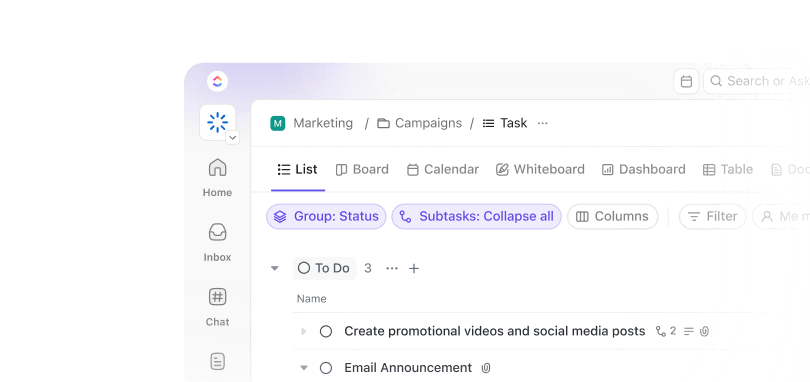Have you ever felt like you’re drowning in a sea of tasks? Or maybe you’ve started a project with the best intentions, only to find yourself hours later, still staring at the same blank page?
If yes, it’s time to introduce yourself to timeboxing. ⏲️
Timeboxing is a powerful time management technique for productivity. It’s a simple yet effective way to break your tasks into manageable chunks and assign specific timeframes.
Whether you’re juggling multiple tasks or just trying to stay on top of your daily important tasks, timeboxing helps you work smarter, not harder.
How to Use Time Boxing to Improve Productivity
What Is Timeboxing?
Timeboxing is a time management strategy that involves scheduling a particular task and completing it within predefined time blocks or slots. You select a specific task and allocate a realistic amount of time to complete it.
The idea is to work on the particular task only within the allotted time slot, stopping when the allocated time is up, whether or not the task is complete. This creates a sense of urgency and focus, preventing procrastination and ensuring you make progress on your goals.
So, how does time boxing differ from time blocking?
While both techniques involve scheduling time for specific tasks, time blocking is more general. It’s like creating broad categories in your calendar, such as ‘work’ or ‘personal.’ There is no specific end time for task completion.
The timeboxing time management technique, on the other hand, dives deeper, assigning specific timeframes to individual tasks within those categories for focused work sessions. Its purpose is to avoid procrastination or overworking on a single task.
There are two types of timeboxes:
Hard timeboxes
In this technique, you have to follow a strict deadline for each task. Once the timer goes off, you move on to the next sprint. You can use any time-tracking app for this. This strict limit timebox is useful in team settings, where deadlines are critical, and you have to deliver the work on time.
Soft timeboxes
These timeboxes are more flexible. You set a target completion time, but you can extend the time limits slightly. Personal tasks often use soft timeboxes, where there’s less time constraint, and the consequences of running over time are less severe.
This flexibility is beneficial when dealing with creative tasks, where the output is harder to predict.
Timeboxing helps teams stay on track and meet deadlines. By setting clear time limits for each project phase, teams can avoid the common pitfall of tasks expanding beyond their original intent and deadlines slipping.
It also helps create a structure in your day. You can easily make time for important but often neglected activities, such as exercise, learning, or spending family time with timeboxing.
Moreover, a study found that setting deadlines (like timeboxes) can improve task completion rates. So, timeboxing helps you focus and also ensures you get things done.
Steps to Start Timeboxing Effectively
Timeboxing can transform how you manage your day. Here’s how you can implement time boxing:
1. Setting the appropriate time
The first step in timeboxing is determining the right time for each task. This can be tricky—set the timebox too short and you might feel rushed; too long and you tend to lose focus.
A good rule of thumb is to start by estimating how long a task usually takes and then reduce that time by 10-20%. This slight reduction pushes you to work more efficiently while keeping your goals achievable.
However, do not underestimate the time a task will take.
A study found that people consistently underestimate the time required to complete tasks. Consider factors like task complexity, your experience level, and potential distractions for better time management.
2. Visualize your schedule
Visualizing your timeboxes can help you stay organized and motivated. It reduces decision fatigue because your plan is already laid out.
Project management tools like offer a range of features, such as Calendars, Timelines, or Task Lists to help you view your timeboxes at a glance.
3. Allocating time for unpleasant tasks
We all have those tasks we dread—whether it’s answering a difficult email, organizing paperwork, or tackling a tedious project. These tasks often get pushed to the bottom of the list, but timeboxing can help you face them head-on. Allocate a specific, short timebox for these unpleasant tasks to make them more manageable.
4. Determining the maximum timebox time
There’s no one-size-fits-all answer when it comes to the ideal timebox length. Experiment to find what works best for you. A good starting point is 30-minute intervals to create a sense of urgency. However, if you’re frequently running out of time or feeling overwhelmed, try shorter timeboxes.
5. Rewards to boost motivation
Celebrate your accomplishments to maintain motivation. After completing a timebox, reward yourself with short breaks, a healthy snack, or a few minutes of relaxation. This positive act will help you stay motivated and prevent burnout.
Timeboxing is not just about personal productivity and time spent; it’s also about creating a balanced life. Ensure you schedule time for rest, hobbies, and social activities. People who take regular breaks are more productive and less stressed.
Having the right tools can make all the difference when implementing timeboxing. But where do you even begin? That’s where for Time Management, comes into play.
As an all-in-one productivity platform, streamlines your workflow with built-in time tracking and task management features.
- Start by creating a task for each activity you want to do in the Timebox with Tasks. This could be anything from writing a report to planning a meeting. In , tasks can be as detailed or as simple as you need them to be

- Set a time estimate for each task. This helps you define the length of your timebox. For instance, if you’ve allocated 45 minutes to complete a task, enter that estimate so it’s visible on your task
- Once you start working on a task, use ’s Time Tracker to monitor how much time you’re spending. This feature is invaluable for ensuring you stick to your Timebox and don’t let tasks drag on


- After completing a timebox, you can review it for better time management. If you consistently find that certain tasks need more or less time, you can adjust your timeboxes accordingly


That’s not all! offers numerous templates that make timeboxing a breeze.
’s Time Box Template is perfect for setting up timeboxes quickly. With this template, you have an organized structure that helps you stay focused on the task. It gives you more clarity in completing projects and more control over time management techniques and resources.
The template includes:
- A Tasks Planner View to plan out tasks and create a timeline for completion
- A Time Box Schedule View with a visual representation of your timeline to keep track of progress
- A Tasks Status View, which offers a quick overview of each task in your project
also offers a Time Allocation Template, which helps you allocate your time more effectively across different tasks and projects. ’s Time Allocation Template enables you to prioritize tasks and offers enough flexibility to adjust your schedule.
This template comes with:
- The Task List View to plan, create, and assign tasks to yourself or your team members
- Time Allocation View to outline and allocate exact time slots to each task so you don’t overbook yourself
- Additional features like Calendar View and Automations to remind you deadlines and stay on top of your tasks
💡Pro Tip: Time management means organizing and managing your schedule to make the most of your days and achieve your goals. Use ’s Time Management Schedule Template to examine how you spend your time in a day or week and optimize your schedule.
These time blocking templates provide a solid foundation to customize your timeboxing routine.
also integrates with other project management tasks and tools via Integrations to complement your timeboxing strategy. For instance,
- Integrate Google Calendar with to sync your tasks and timeboxes with your calendar events
- Integrate Slack with so that your timeboxing efforts are transparent and collaborative. You can set up notifications in Slack for when Timebox starts or ends, keeping everyone in the loop and accountable
Incorporate these tools within to enhance your timeboxing and give a holistic approach to managing your time and tasks more effectively.
Timeboxing for teams
Timeboxing isn’t just for individual productivity; it’s a powerful tool for teams as well. Implement timeboxing across your team to enhance collaboration and achieve shared goals.
Start by discussing the benefits of timeboxing and how it can improve your team’s workflow. With ’s Task Management feature, you can create and assign tasks with specific timeboxes for each team member. This ensures that everyone knows what they need to work on and how much time they have to complete it.
Create shared Workspaces within where team members can collaborate on projects. Define task dependencies to ensure that tasks are completed in the right order and avoid bottlenecks.


You can also create a shared calendar with ’s Calendar View where team members can visualize everyone’s timeboxes. It helps prevent scheduling conflicts and ensures everyone is on the same page.


’s Workload View makes it easy to monitor progress and keep everyone on track. This feature helps you see how time is allocated across the team so that no one is overburdened.


Team meetings are often notorious for dragging on longer than necessary, but timeboxing can change that. By setting strict timeboxes for each agenda item, you can keep meetings focused and efficient. For example, if you allocate 10 minutes for a project update, the team knows they must stay on topic and make decisions quickly.
’s Meeting Minutes Template allows you to document key decisions and action items within the timeboxes, ensuring that nothing is missed and that the meeting’s outcomes are clear and actionable.
Also, timeboxing is a fundamental concept in Scrum, an Agile software development framework commonly used in software development and other industries. Scrum teams use timeboxing to structure their work into Sprints, typically 1-4 weeks, where specific tasks or features are developed and completed.
You can also incorporate timeboxing into your daily stand-ups and sprint planning. Allocate specific time slots for each team member to update their progress and discuss any blockers.
Tips and Best Practices for Effective Timeboxing
Timeboxing is a powerful tool, but it is most effective when applied thoughtfully.
- If you’re new to timeboxing, begin with shorter timeboxes and gradually increase the duration as you become more comfortable
- To refine your timeboxing strategy, track how long tasks take. This helps you adjust future estimates and avoid underestimating or overestimating timeframes
- To make the most of your timeboxes, prioritize tasks based on their importance and urgency
- Create a distraction-free environment to maximize focus during your timeboxes
- While timeboxing is about structure, be prepared to adjust your timeboxes if unexpected events arise
- Regularly review your timeboxing schedule and make adjustments as needed
- If you’re timeboxing as part of a team, communicate clearly to ensure everyone is aligned and working efficiently
- Don’t forget to celebrate your accomplishments! Completing a timebox is a victory. Reward yourself with a short break or a small treat to support positive behavior
Timeboxing is a tool, not a rigid rule. Experiment, find what works best for you, and adapt your approach. With consistent practice, you’ll master timeboxing in no time.
The Pros and Cons of Timeboxing
Timeboxing offers numerous benefits, but it’s not without its challenges. Let’s explore both sides of the coin:
Pros of timeboxing
- Improved focus: Timeboxing eliminates distractions and promotes deep work, allowing you to concentrate on one task at a time
- Enhanced productivity: By setting clear deadlines and defining specific tasks, timeboxing can significantly boost your productivity
- Reduced stress: A structured approach can reduce overwhelm and anxiety, making it easier to manage your workload
- Better time management: Timeboxing helps you prioritize tasks and allocate time effectively. It prevents procrastination and ensures that you meet important deadlines
- Increased accountability: Timeboxing creates a clear framework for accountability, both for you and your team
Cons of timeboxing
- Risk of rushed work: Strict timeboxes can sometimes lead to rushed work if tasks are more complex than anticipated
- Potential for being overwhelmed: If you’re new to timeboxing, creating and sticking to a schedule may feel overwhelming initially
- Inflexibility: Timeboxing, by its nature, can sometimes feel rigid, especially when unexpected tasks or interruptions arise
- Over-scheduling: There’s a temptation with timeboxing to fill every minute of your day with tasks, which can lead to burnout. It’s important to leave some breathing room in your schedule for reflection, creative thinking, or to handle unexpected tasks that crop up
To mitigate these potential drawbacks, consider the following strategies:
- Start small: Begin with shorter timeboxes and gradually increase the duration as you become more comfortable
- Be realistic: Set achievable goals and adjust your timeboxes accordingly
- Allow for flexibility: While timeboxing is about structure, it’s also about adaptability. Be prepared to make adjustments if necessary
- Prioritize tasks: Focus on the most important tasks and allocate adequate time to complete them
Implement Timeboxing with
Are you tired of feeling overwhelmed and unproductive? Timeboxing helps you conquer chaos and achieve your goals. By breaking down tasks into bite-sized pieces and setting strict timers, you’ll be able to focus better, eliminate distractions, and boost your productivity.
is your go-to tool for making timeboxing a breeze.
Its user-friendly interface and powerful features streamline the process, helping you implement timeboxing effectively. So, what are you waiting for?
Sign up for free on and experience the power of timeboxing.


Everything you need to stay organized and get work done.













